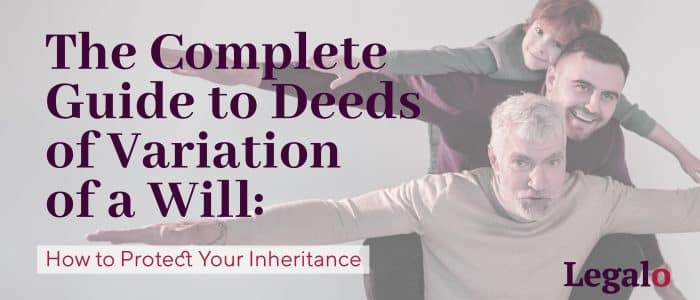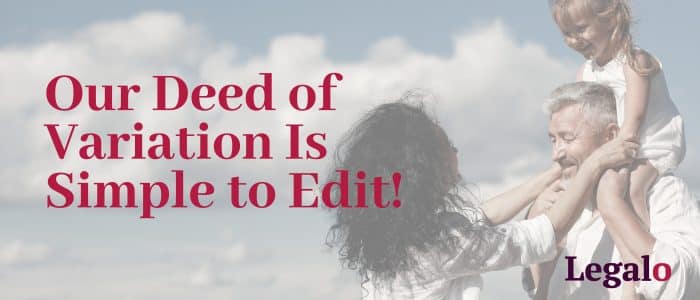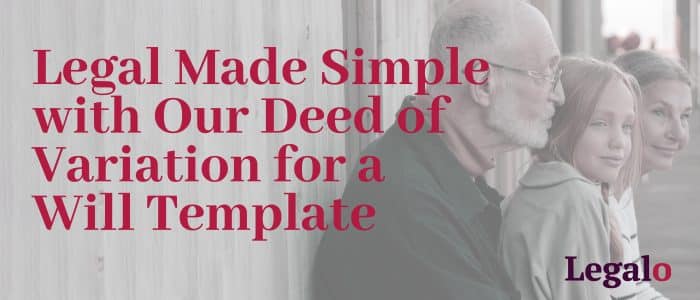Create a Custom Deed of Variation for a Will – Guide & Template
David Cammack
Use our deed of variation of a will template to change the entitlements of beneficiaries of a will.
You can use it to change the will of a person after their death. That means you can change the beneficiaries to whom parts of the estate go. With our helpful guide and template Deed of Variation, deeds of variation are easy to put in place.
The template deed can be easily customised to apply to one or more beneficiaries.

What is a Deed of Variation for a Will?
A deed of variation for a will is a legal document that is used to change the terms of an existing will. It allows a beneficiary (a person inheriting under the will) to change the will of the person that has died (known as the testator).
The deed of variation operates to change who inherits where someone has left a will.
This type of deed is for use after the death of the person that left the will. If a person is still alive they do not use a deed of variation for a will. Instead they can change their will by using a Codicil to a Will.
Bear in mind that you would only use this template where a valid will exists. If a will does not exist, then use the deed of variation on Intestacy template instead.
In the UK you can make the variation either before, or after, you obtain probate for the estate. However, please note that any variation must be done within two years. That is two years from the date of the death of the deceased.
People regularly ask us for a deed of variation for probate, a deed of variation after probate or a will variation agreement. These are all different names for the same deed document.
Use our simple deed of variation template to vary the will’s terms. Divert all or some of that inheritance to someone else.
How a Deed of Variation for a Will Works
The deed of variation for a will works to change the will of the person that has died. It can be used to add beneficiaries, alter to whom assets are distributed, or how they are distributed.
A deed of variation like this only works when all of the existing beneficiaries under the will sign it. So it is important that all beneficiaries agree to the changes.
Use a deed of variation where a person has died and has left a will. If he deceased has not left a will you would use a different document to vary the entitlements of the beneficiaries of the estate. If a will does not exist, then use a deed of variation on Intestacy template instead.
The deed of variation can be put in place after probate has been obtained. However, you must get it in place within two years of death.
You’ll also hear this type of deed of variation referred to as a ‘deed of variation for a will after death‘ or a ‘inheritance variation deed template’. Just a few of the ways of referring to a deed of variation of a will.
The template is downloadable in Word format. Using the Word document you can also save it as a PDF for signature. You will need access to a laptop or computer running Microsoft Word (or an equivalent).
This page contains a summary from the full guide that is included when you buy and download Legalo’s Deed of Variation for Will template.
When To Use Our Deed of Variation of a Will
Our template deed of variation of a will has several options within the template, so it is suitable for use:
- To divert/vary part or all of the person’s inheritance under the will; or
- Where there was an asset that was owned jointly with the deceased under a “joint tenancy” (e.g. a house) which, as a result of the death, has now become owned solely by the survivor; or
- In diverting/varying the legacy to:
(a) someone else who is a beneficiary under the will or(b) someone who would not otherwise be a beneficiary under the will; or - Where executors have not taken out a grant of probate. (This is provided that the estate is sufficiently small that you do not need to obtain a grant of probate.
A common mistake that people make is to use this deed of variation where a will has not been left.
The deed of variation of a will is not suitable for use for someone who has died “intestate”. That means they died without leaving a valid will. You need a slightly different deed to vary it, but a suitable one is available from Legalo: deed of variation for intestacy template. By applying the rules of intestacy, you can see who the beneficiaries would be in an intestate estate.
The Benefits of a Deed of Variation
There are many benefits to using a Deed of variation. These include:
- The ability to vary a will after the death of the person that made the will.
- It allows existing beneficiaries to add new beneficiaries.
- Existing beneficiaries can re distribute the estate between themselves.
Creating a Deed of Variation for a Will
A deed of variation can be created in one of two ways:
- By hiring a solicitor to draft the deed of variation for you.
- Purchasing a deed of variation for a will template and creating the document yourself.
if you opt for drafting the deed yourself you will save money. However, it is important that you use a quality document template. Preferably a template that comes with a guide.
Our templates are all drafted by qualified solicitors who are registered to practice law in England and Wales.
Using a Solicitor vs. Using Our Deed of Variation for a Will Template
Using a solicitor will provide you with the opportunity for an in person meeting. However, it will also be relatively expensive. You can expect to be charged between £350 and £500 plus VAT for a solicitor to create the document.
Benefits of Using Our Template
The main benefit of using a deed of variation is that it acts as if the variation had been made by the deceased person that left the will. This enables a beneficiary under the will to redirect all or part of their inheritance to another person without them incurring any tax implications.
The Deed of Variation is an effective way of changing a will. There are several other ways to change a will which our other guide takes you through.
Creating a Deed of Variation for a Will After Probate
The deed of variation can be created before or after probate. Thy can even be crated after the estate of the deceased has ben distributed. However, a limitation is that the deed of variation must be created within two years of the death of the deceased. Otherwise the variation will not be legally binding. To be legally valid the deed must be signed by all of the original bneficiaries who will ‘lose out’ from the variation, as well as all the executors of the deceased’s estate.
Trusts and Deeds of Variation for a Will
If you are varying the estate to put the assets into a new trust (i.e. not one already in existence or one created by the will), then you will separately need to create that trust.
The deed of variation does not do that for you. Legalo do not offer any trust deeds (except a simple “bare trust” deed), so if you want to make tax savings or to use a “discretionary trust”, you will need to instruct a solicitor to draft one for you. This is because (other than bare trusts) they are complex and the tax situation needs to be fully understood. If you already have a trust established, then you can vary the will, to divert the assets into a trust. You can use our template deed of variation for this. The new beneficiary will be the existing trust.
Inheritance Tax and Deeds of Variation for a Will
Any changes to the will are treated by HMRC as if the deceased had written them. This is provided that the variation is made within two years of the deceased’s death. This can enable a more tax efficient distribution of the deceased’s estate. For example a re distribution can enable a more effective use of tax exemptions and tax reliefs. For more information on inheritance tax see the Government’s website.
Common Questions About Deeds of Variation for a Will
I explain above the key items that, as a solicitor, I believe you should consider when looking to change a will using a deed of variation. We regularly receive questions relating to our deed of variation for a will. I answer the most common questions below.
Can I write my own deed of variation?
Yes you can. We recommend that you purchase a professionally drafted document template first. Make sure it has been drafted by a qualified solicitor. You then get pace of mind in knowing that it is a legally binding and effective document.
Can you do a deed of variation without a solicitor?
Yes you can do a deed of variation without a solicitor. It is advisable to use a well drafted template. Being a solicitor I recommend that you ideally purchase a document template that has been drafted by a solicitor. Our deed of variation template has been draft to modify a will after death by myself. I am a practicing solicitor in England.
How much does a Deed of Variation cost?
If you hire a solicitor to create the deed of variation it is likely to cost between £350 and £500 plus VAT. You can expect a solicitor to complete the document drafting in up o one week.
Alternatively, you can purchase a document template to create your own legally binding deed of variation of a will. Document template prices vary from between about £25 to £75. Our template is priced at just £49.
How do I write a Deed of Variation?
When writing a Deed of variation of a will, we recommend using a professionally-drafted template. The deed of variation is a legal document and it is vital that it is drafted correctly to be effective. Our template document has been drafted by myself, David, a qualified solicitor. The guide that is included with the template provides detailed guidance on each step required to complete the document.
How quickly can a Deed of Variation be done?
On average it takes about twenty to thirty minutes to complete drafting a Deed of variation if you use a good template. Legalo’s template has been drafted by myself, a qualified solicitor, and includes a guide to completing the document.
Do you need probate to do a Deed of Variation?
No, you do not need probate to do a deed of variation to a will. The variation must be made within two years of the death of the deceased, but can be done before or after probate. If done before probate, then you might not be able to pass the asset over until the executors have obtained probate.
What are the disadvantages of a Deed of Variation to a Will?
- It is only possible to put in place a Deed of Variation once in relation to the same assets.
- Once created, a Deed of Variation for a Will cannot be revoked.
- If a person receiving government benefits varies their inheritance, it may still be included as part of their means-testing, even though they have not received it.
- All affected beneficiaries under the will must sign the deed of variation, creating a risk that some may not sign.
- Without a deed of variation, passing an inherited asset to someone else is seen as a gift from the original beneficiary to the new beneficiary. This would have the risk of being part of the original beneficiary’s estate for inheritance tax purposes if they do not survive for seven years after making the gift. By using a deed of variation, this risk is removed.
- It is not possible for a party making the gift by way of the variation to retain any interest in the gifted asset.
- If the value of the gifted asset has increased between the date of the deceased’s death and the date of the variation, a Capital Gains Tax charge may arise.
Do I need to notify HMRC of the Deed of Variation?
A further issue to consider is whether the variation to the will result in more Inheritance Tax becoming payable.
This is rare, but if it does, then HMRC must be notified. Make the notification to HMRC within six months of the date of the deed of variation.
You also need to notify HMRC if you are passing on an investment asset (e.g. shares or an investment property) that would have a capital gains tax liability if it were sold now, and you want to roll the accrued capital gain over (so the tax becomes due only when the person you are passing it to sells it) – you must notify HMRC of this. Full details on how to notify HMRC can be found here.
For advice on tax issues about the variation to the will, you will need to consult a specialist. Ideally, this would be a specialist such as a probate solicitor, or an accountant that deals in Inheritance Tax advice.
Legalo Ltd is unable to provide such advice. However, we can put you in touch with an appropriate probate solicitor. We operate a panel of vetted and approved law firms that can assist when required.
You may also find the following article helpful and which explains how to calculate Inheritance Tax: https://www.moneyadviceservice.org.uk/en/articles/calculating-and-paying-tax-after-someone-dies. The Inheritance Tax Act legislation can be viewed here.
Even when you don’t need to send a copy to HMRC, the Current Beneficiary should keep the original deed safe. Ensure all the other parties have had a copy of it.
Keep the Deed Safe
You might need to produce it in the future if the party named as the Current Beneficiary (see below) dies within 7 years of the date of the deed of variation. In such a case, the deed will demonstrate that the original inheritance was never received by the Current Beneficiary. Therefore, it does not constitute a taxable gift made by them in their lifetime.
It might otherwise be liable for Inheritance Tax if they died within 7 years of making such a gift. That is the core purpose of the deed of variation: avoiding this tax risk. This is where you are aiming to reduce the amount of Inheritance Tax – for the Current Beneficiary’s estate, not the estate of the person who left them the gift.
For details on how to go about obtaining a grant of representation / probate, if you need one, see the Government’s website at https://www.gov.uk/wills-probate-inheritance/overview.
Cost of a Deed of Variation
Our deed of variation template costs £49. The solicitors’ fees for a deed of variation would be about £700 plus VAT, but they can vary considerably. Therefore, you get a great saving if you create the deed yourself.
A deed of variation is very simple to finalise and put in place. Especially when you start with a professionally-written template! Our great guide to completing the template helps too. You get both for just £49 when you purchase the deed of variation template from us.

Clauses in our Deed of Variation of a Will
Below is an explanation of the main clauses that our deed of variation of a will contains.
Date of Deed
Insert just the year at this stage.
Hand write the rest of the date in the deed once all the parties have signed it.
Parties to the Deed of Variation
You will need to insert the names and addresses of party 1 and party 2. These are the original beneficiary under the will and the person to whom the assets are diverted.
If party 1 comprises more than 1 person, write in all their names and addresses. Also add the word “together” before the words in quotes “the Current Beneficiary”. Then add further signature clauses at the end of the deed of variation.
If the variation to the will causes more Inheritance Tax to arise on the estate, then the Personal Representatives of the estate (i.e. the Executors of the deceased) should also be parties to the deed. If so, then add them as party 3, in similar form to the other parties. Also add an additional signature clause (or as many as are needed) at the end of the deed. Use the same format as the others, with the extra party’s name in it.
The same applies if there is more than one person as the “New Beneficiary”, so follow the steps above.
Variation of Joint Tenancy Property
If the variation relates to property owned under a joint tenancy between the deceased and more than one other party, then you need to name both/all of these other parties as “the Current Beneficiary”.
To do this, list their name(s) and address(es) in the same paragraph as party 1 and before the words in quotes “the Current Beneficiary” add the word “together” (not in quotes).
Also add an additional signature clause (or as many as you need). This goes at the end of the deed, in the same format as the others.
Background To the Variation
This section sets out basic information relating to the deceased and the will that is to be varied.
(A) Fill in the name of the deceased and the date of their passing. If there was one or more codicil to the will, then keep the words in square brackets at the end of line 1 – make it plural or singular as appropriate – and keep the word together on line 2. If not, delete the words in square brackets at the end of line 1 and on line 2.
(B) Depending on how many assets are being diverted to the new beneficiary by this deed of variation, it may be easier to list them in this clause or in the schedule. if so select which option you are using. Then fill in the details to identify them clearly, whether you are doing so in this clause or the schedule.
If not using the schedule for this purpose, then delete the schedule in the deed of variation of a will. Select the correct options as to whether the assets are owned jointly with the Current Beneficiary or solely by the deceased.
It may be simpler to refer to the Share of the estate to which the current beneficiary is entitled being diverted in full to the new beneficiary. If so, then delete this clause B and the schedule, and deal with the variation under clause C.
(C) Here you need to select which option applies on line 1. It may be easier to refer to the whole Share of the estate being diverted to the new beneficiary if this is the case, rather than by referring to certain Assets in clause B.
If, under the terms of the will, the current beneficiary is entitled to the whole of the estate of the deceased (the net estate after paying the Inheritance Tax and debts due is known as the “residuary estate”), then you may prefer to refer to the Residuary Estate.
Whichever applies, select the relevant option and fill in the fraction or percentage entitlement of the current beneficiary if relevant. If deleting clause B, then when referring to the Assets, ensure you keep the wording “the assets described in Schedule 1 (“the Assets”)” in clause C, as you will otherwise have deleted the definition of them when deleting clause B. If keeping clause B, you can delete those words.
(D) Select the relevant options that apply here.
Numbered clauses in the Deed of Variation
1. Interpretation of the Deed
This clause sets some basic rules of interpretation of the deed. If you have deleted the schedule, you can delete the words in square brackets in clause 1.3.
2. Variation of the Will
This clause is the main part of the deed of variation of a will template. It effects the variation of the estate.
Complete the clauses as appropriate. Depending on how much of the inheritance you are diverting, edit accordingly. In clause 2.1, fill in the details as appropriate and select the options that apply.
In lines 1 to 4 of clause 2.2, fill in the details as appropriate and select the options that apply. Select whether the assets are passing free of Inheritance Tax in the hands of the new beneficiary (i.e. the residuary estate has already paid it or someone else is paying it out of their share of the estate) or subject to the new beneficiary’s paying the Tax out of this gift.
If you are passing the whole of the current beneficiary’s entitlement, under the terms of the existing will, to the new beneficiary, then delete the whole of the phrase on lines 3 to 4 of the template that is in square brackets.
If not, within that last section, keep or delete the phrase “(net of any inheritance tax liability arising on the gift to the New Beneficiary)”, depending on who is bearing the burden of the relevant Inheritance Tax.
On line 6 of clause 2.2, of the template, if no income has yet arisen (since the date of death) from the assets being diverted or if the accrued income is not to be transferred to the new beneficiary with them, then delete the words “[payable after the date of this deed]”. In the last line of clause 2.2, again choose the right option. This depends on whether the gift is subject to Inheritance Tax in the hands of the new beneficiary or not.
Where the New Beneficiary is in fact more than one person and they are sharing the Asset (or whichever definition you are using – e.g. Share, Legacy or Residuary Estate), then state in clause 2.2 that they are receiving it “in equal shares”, by adding those words after the words “given to the New Beneficiary” on line 3. If they are not receiving it in equal shares, you may prefer to do one deed for each New Beneficiary, instead of bundling them together into one deed (as you may find this simpler). If you decide to do more than one deed, you only need to buy it once from Legalo and you can then use it as many times as you need for this estate
In clause 2.3, choose whether or not it is subject to Inheritance Tax in the hands of the New Beneficiary.
If the assets were not subject to a joint tenancy between the current beneficiary and the deceased, then delete the clause 2.4.
When keeping clause 2.4, if the joint tenancy was just between the two of them, then keep the words “in equal shares” on line 4.
If there were more than 2 joint owners, then specify the basis of ownership. E.g. “as to one third owned by the Deceased and the rest by the Current Beneficiary” if there were 3 owners in the joint tenancy.
Select the applicable options in the last 4 lines of this clause. Whether the share of the Assets is:
- to go to the new beneficiary as if left as a legacy under the will; or
- simply to pass into the estate of the deceased and for distribution in accordance with the will, as with the rest of the estate.
If the former, then choose whether or not it is subject to Inheritance Tax in the hands of the New Beneficiary. If the latter, then choose the correct reference to “his” or “her” in this option.
3. Statement of Tax Position
This clause in the deed of variation of will declares whether relevant parts of 2 tax laws apply. They are the Inheritance Tax Act 1984 and Taxation of Chargeable Gains Act 1992 apply or not. I.e. if you intend the variation to have retrospective effect. It would then apply as if the gift made by the variation were instead a gift made by the deceased via his or her will, for the purposes of Inheritance Tax and Capital Gains Tax.
For the terms of the deed to have such retrospective effect, it must contain a specific statement. “All the relevant persons” must make the statement. This is in accordance with section 142(2) of the Inheritance Tax Act 1984). I.e. the Current Beneficiary (and the Personal Representatives if there is an increased Inheritance Tax bill as a result of this variation) or “by the persons making the instrument”. I.e. signing this deed (in accordance with sections 62 (6) & (7) of the Taxation of Chargeable Gains Act 1992) that they intend the relevant sections to apply to the variation.
The Personal Representatives may refuse to join in the statement if there are insufficient assets. Insufficient within the estate to pay the increased Inheritance Tax charge.
Amend the statement where the parties intend that one or both sections should not apply. You will always need the first part of the statement about Inheritance Tax, as this has the key “deed of variation” effect of ensuring the money gifted by the deed of variation is treated as never being received by the Current Beneficiary, so never delete this.
Capital Gains Tax
The second part about capital gains (the Taxation of Chargeable Gains Act 1992) is optional. So here you do need to make a choice. If you have not sold off all the investment assets in the estate such as an investment share portfolio or an investment property that was rented out (you are generally ignoring the deceased’s main residence for this purpose) then there may be a capital gain on which the estate has to pay tax when it is sold. If you prefer to pass that asset on to the New Beneficiary without paying the capital gains tax now, but making the New Beneficiary potentially liable for the accrued gain when they eventually sell it, then keep the next section by choosing “and” in the option in the middle of this clause, and deleting “but not”.
In the case of your electing that section 62(6) of the Taxation of Chargeable Gains Act 1992 applies to the variation, you need to give notice of this variation to the Inland Revenue. So send them a copy of it (and possibly also complete a form – check the HMRC’s website about this process). In other cases you do not need to inform them. The Current Beneficiary simply keeps the original signed deed of variation. We would suggest that they store it with their Will.
4. Stamp Duty on share transfers
This clause is optional. You only need it if the assets that are the subject of the variation are, or include, shares. “Shares” means stocks, shares or other marketable securities. If they do, then keep this whole clause. As the variation has to be by way of a gift, then the clause should be correct as it stands. Therefore the transfer of the shares should be exempt from Stamp Duty. If the assets do not include any shares, then delete the whole clause.
Schedule to the Deed of Variation
As noted above, either fill this in or delete it as applicable.
Signing a Deed of Variation
The Current Beneficiaries (i.e. those affected by the deed of variation of the will) must sign the Deed of variation. Technically, the New Beneficiaries do not need to sign unless they are agreeing to pay any Inheritance Tax due in respect of the property that is transferring to them. It is common for the executor(s) to also sign. However, this is not a legal acquirement unless the variation will give rise to a change in Inheritance Tax.

This is a summary guide. The template deed of variation download includes the complete version with its download. Do browse our full range of Wills and Probate templates and other legal documents that we have available. if you would like to read even more information on changing a will after death read that guide too.
Get Legal & Compliance tips straight to your inbox, free!
"*" indicates required fields

